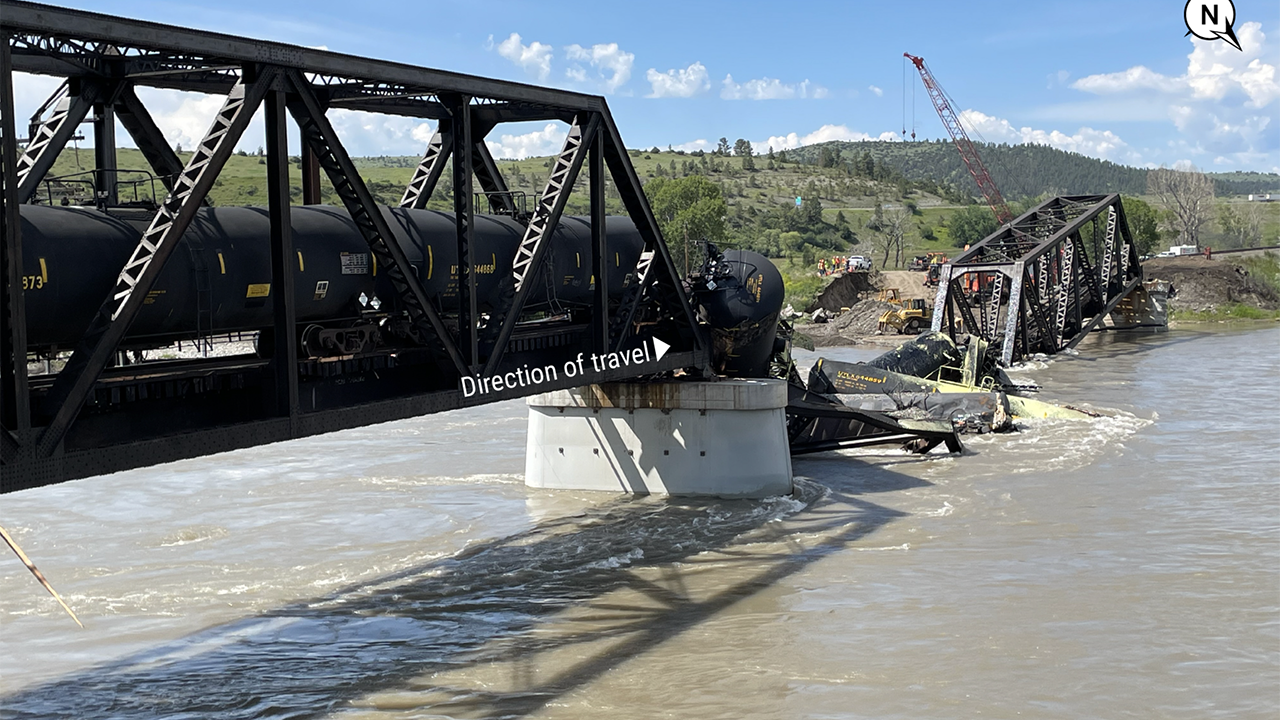
NTSB Issues MRL Derailment Preliminary Report
Written by Marybeth Luczak, Executive Editor
View of the accident scene, courtesy of NTSB.
The National Transportation Safety Board (NTSB) has released a preliminary report for its investigation of the performance of DOT-111 tank cars in a Montana Rail Link (MRL) train that was involved in a derailment and bridge collapse on June 24, 2023.
“On June 24, 2023, about 6:14 a.m. local time, Montana Rail Link (MRL) freight train MLEUMIS123, a 55-railcar key train, derailed near Reed Point, Stillwater County, Montana,” according to the report, which NTSB issued July 24 and said contains information that is preliminary and subject to change. “The train was crossing the MRL 51 bridge over the Yellowstone River at a speed of 38 mph when 16 tank cars derailed at milepost 51.6. Sixteen railcars in positions 36 through 52, 15 of which were loaded with hazardous materials (hazmat), derailed. Ten derailed railcars submerged in the water, nine of which were hazmat tank cars. No fire, injuries or evacuations were reported. Visibility conditions at the time of the derailment were daylight and clear; the temperature was 53°F. There was no precipitation, and the wind was out of the north-northwest at 17 mph. Three local water treatment facilities downstream of the derailment were shut down, but emergency protective measures were lifted by noon of that day.”
The report said the 3,280-foot-long train originated from Laurel, Mont., and was destined for Missoula, Mont. Of its 55 cars, 47 were loaded and 35 contained hazardous materials. The track speed limit was 45 mph on the approach to the bridge, then reduced to 40 mph on the curve.
According to the NTSB report, although the train “did not meet the definition of a high-hazard flammable train as defined in Title 49 Code of Federal Regulations (CFR) 171.8, it met the April 1, 2020, edition of United States Hazardous Materials Instructions for Rail, definition of a key train by having 20 or more loaded hazardous materials shipments or intermodal portable tank loads having any combination of hazardous material and was listed on the train’s consist as such. This train was subject to the safety and security planning requirements of 49 CFR Part 172, Subpart I.”
All the submerged hazmat tank cars were U.S. Department of Transportation (DOT) specification 111A100W1, reported NTSB, which noted that the 15 derailed hazmat tank cars included three loaded with molten sulfur (NA2488), two with sodium hydrosulfide (UN2922), and six with asphalt petroleum liquid (UN2522). The molten sulfur and asphalt petroleum liquid released into the river, it said.
NTSB’s on-scene tank car inspections were completed July 11, and the agency said “preliminary findings show that hazmat releases occurred from nine mechanically breached tank cars. The remaining 26 hazardous materials tank cars did not breach. The NTSB’s investigation is ongoing.”
The Federal Railroad Administration (FRA) is leading all other aspects of the investigation, according to NTSB. An FRA spokesperson on July 24 told Railway Age that its investigation is “active and ongoing,” and its “focus remains on the cause of derailment, as well as understanding the structural failure. EPA remains the lead on environmental cleanup and remediation.”
MRL completed reconstruction work and resumed traffic over the bridge less than a month after the incident.
The bridge is owned by BNSF, but MRL has maintained it since 1987, according to the Class I railroad. MRL began leasing BNSF lines between Huntley, Mont., and Sandpoint, Idaho, at that time and will continue to do so until the lease concludes in January 2024. BNSF will then resume operational control and infrastructure maintenance, the Class I told Railway Age on June 26.
“The railroad bridge is inspected twice a year and the most recent inspection was performed in May, [MRL spokesperson Andy] Garland said,” according to a June 26 Associated Press report.



